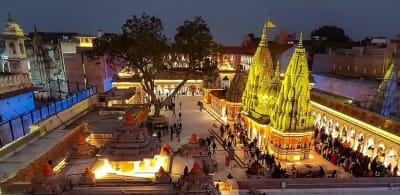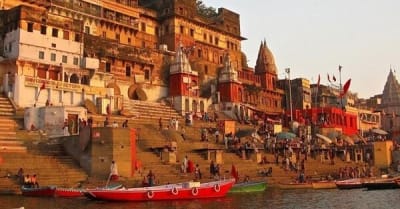The Untold Story of Kashi Vishwanath Mandir Revealed

If you’ve ever been to Varanasi or let’s say if you’ve even seen the pictures, you already know that it’s no ordinary city. There’s something ancient in the air that makes you feel unchanged even in the middle of chaos. And somewhere that admits this unique peace and tranquility, stands one of the most important temples in the Hindu world: Kashi Vishwanath Mandir.
But what many people have no idea how much this temple has been through. Today it stands as a testament not just to the power of Lord Shiva but also as a resilience that was destroyed and rebuilt more than once, standing today stronger than ever. Let’s walk through the real story of Kashi Vishwanath.
Kashi: A City That Never Sleeps, Never Dies
 First, a little about the city itself.
Kashi, also known as Varanasi or Banaras, is said to be older than history — literally. According to the Skanda Purana, Lord Shiva founded this city himself. It’s one of the seven Moksha-puris — places where people believe they can attain salvation.
First, a little about the city itself.
Kashi, also known as Varanasi or Banaras, is said to be older than history — literally. According to the Skanda Purana, Lord Shiva founded this city himself. It’s one of the seven Moksha-puris — places where people believe they can attain salvation.
But Kashi isn’t just about death and afterlife. It’s a city that breathes with rituals. Every sunrise is greeted by chants. Every sunset is met with Ganga aarti. And at its spiritual center is the Kashi Vishwanath Temple, dedicated to Shiva — “The Lord of the Universe.”
So When Was the Temple First Built?
No one knows the exact year. But we do know this — the temple is ancient. There are references to it going as far back as 2nd century BCE, and it’s been mentioned multiple times in old scriptures like the Skanda Purana. So it’s safe to say: it’s been around for over 2,000 years. Originally, it stood right where the Gyanvapi Mosque stands today. That’s where the heart of this story begins.
The Temple That Was Torn Down Again and Again
 Here’s where it gets painful — and powerful.
The Kashi Vishwanath temple was destroyed multiple times over the centuries. Not once. Not twice. But at least three major times.
Here’s where it gets painful — and powerful.
The Kashi Vishwanath temple was destroyed multiple times over the centuries. Not once. Not twice. But at least three major times.
- In 1194 CE, it was first demolished by Qutb-ud-din Aibak during an invasion led by Muhammad Ghori.
- In 1447 CE, it was attacked again under the rule of Hussain Shah Sharqi of Jaunpur.
- Then it was rebuilt during the time of Akbar, by Raja Todar Mal.
- But the biggest blow came in 1669 CE, when Aurangzeb ordered the final destruction and built the Gyanvapi Mosque in its place.
This wasn’t just political — it was deeply emotional. Imagine having your most sacred space replaced by a structure meant to erase your faith. But it didn’t work. People kept the memory of Vishwanath alive. Some even continued to secretly worship nearby. Faith, somehow, didn’t die.
The Temple and the Gyanvapi Dispute
This part is still sensitive and ongoing, but here’s what we know: The Gyanvapi Mosque stands right next to the current Kashi Vishwanath Temple. In 2022, a court-ordered video survey of the mosque led to the discovery of a structure that many believe is a Shivling, located inside the wazukhana (ablution area).
Hindu groups claim it’s the original Shivling from the demolished temple. Muslim groups say it’s just a fountain. The matter is in court now. But regardless of legal status, for many devotees, the belief has always been that Lord Shiva never left the site. That’s what keeps the energy of the place alive.
The Queen Who Rebuilt What Empires Tried to Erase

Now let’s talk about the comeback. In 1777, nearly a hundred years after the last destruction, a remarkable woman stepped in — Maharani Ahilyabai Holkar of the Maratha Empire. She didn’t just rule. She restored temples across India, including Kedarnath, Somnath, and of course, Kashi Vishwanath.
In 1780, the current Kashi Vishwanath Temple was built — right next to the mosque, on land allowed by the ruling government. She funded it herself. Quietly. Without any grand political statements. Just pure devotion. Later on, Maharaja Ranjit Singh of Punjab donated nearly one ton of gold to cover the temple dome — the golden spire that glints in the Varanasi sun even today.
The Present-Day Temple
Until a few years ago, visiting the temple meant squeezing through narrow, crowded lanes, packed with shops and wires and old buildings. That changed in 2019, when Prime Minister Narendra Modi launched the Kashi Vishwanath Corridor Project. This project:
- Cleared over 300 small buildings to create open space
- Rediscovered around 40 small shrines that had been hidden inside walls and homes
- Created a direct, clean path from the Ganga river to the temple
- Expanded the temple area from 3,000 sq ft to over 500,000 sq ft The newly inaugurated complex (in December 2021) is now spacious, well-managed, and welcoming — while preserving the soul of the original temple.
The Every Day Rituals at the Temple

Every single day, thousands visit Kashi Vishwanath for darshan. The temple has a strict daily routine:
- Mangala Aarti (early morning)
- Rudrabhishek (ritual bathing of the Shivling)
- Bhog Aarti (offering of food)
- Sandhya Aarti (evening aarti)
- Shringar Aarti (night aarti with decoration)
Pilgrims often combine their temple visit with a dip in the Ganga, and it’s considered incomplete without also visiting the Kaal Bhairav Temple nearby. During Mahashivratri, Sawan, and other festivals, the crowd swells to lakhs — yet the temple never loses its rhythm.
Did You Know?
Here are a few lesser-known facts:
- The complex includes over 20 small shrines, many of which were hidden and rediscovered recently.
- The Shivling in the sanctum is tilted slightly — believed to be in the direction of the Gyanvapi well, where the original Shivling is said to lie submerged.
- The entire city of Kashi is considered a living temple — and the Vishwanath Mandir is its heart.
- Every moment, there’s someone praying, somewhere, for someone — and that’s been happening here for thousands of years.
Final Thoughts: Why This Story Still Matters
The story of Kashi Vishwanath Mandir isn’t just about bricks and rituals. It’s about belief that refused to be buried. It’s about people — kings, saints, queens, commoners — who kept a flame alive even when it was almost blown out.
Despite invasions, demolitions, and disputes, this temple never disappeared. It lived in memory. It returned in gold. It rose again in marble. And it stands today — open to all, shining as ever. If you ever find yourself in Varanasi, don’t just go for a darshan. Stay a while. Soak it in. Because what you’ll feel there isn’t just devotion. It’s history humming under your feet.




